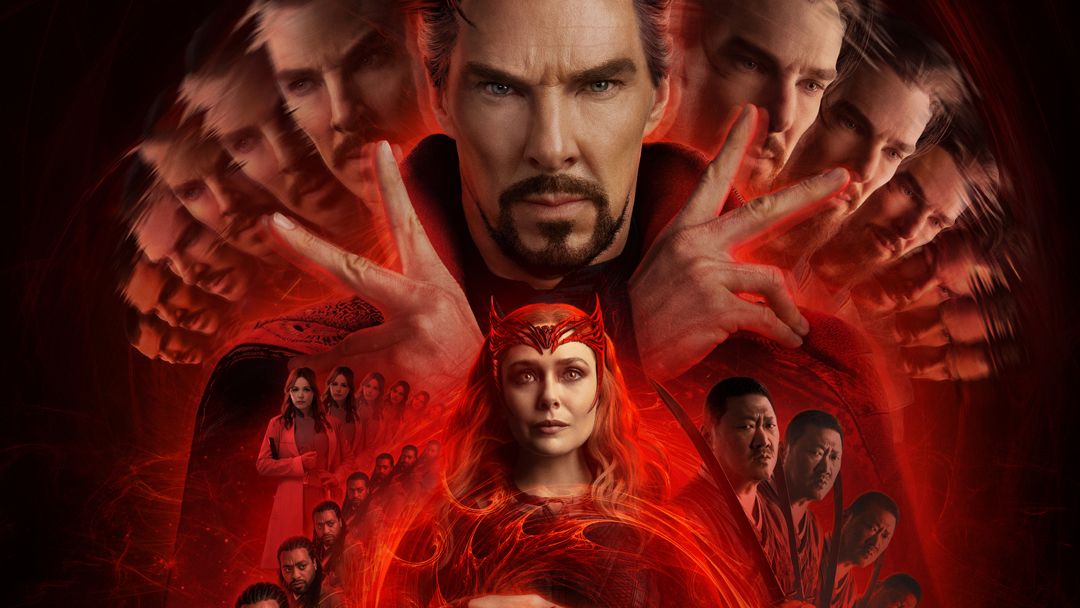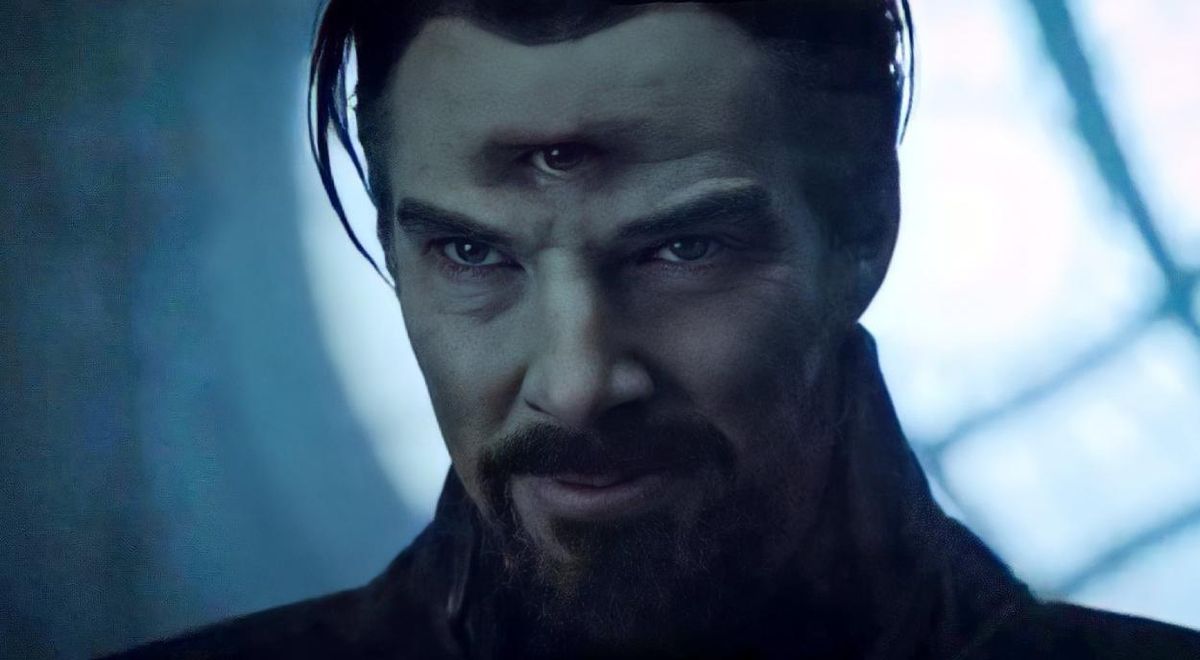REVIEW: Doctor Strange in the Multiverse of Madness (2022)
The highly anticipated sequel to 2016’s Doctor Strange, Doctor Strange in the Multiverse of Madness, was released into theaters this weekend, bringing along with it all the typical Marvel fanfare. This film marks the third first introduction of the multiverse to the MCU, contradicting all the prior set rules of the previously established “first” depictions of the multiverse.
The best way to describe In the Multiverse of Madness is spectacle over substance — albeit with third-rate CGI more at home in 2005 than 2022. All the film’s sequences, both action and dialogue-based, are cobbled together in the most uninspired manner imaginable to deliver as much into the audiences’ retinas as possible while never truly saying anything. The empty and vapid nature of this film is exemplified in every frame of this flashy and “exciting” narrative. It was as if the writers believed that the audience were toddlers enthralled with the flashing lights and pretty colors, the most primal parts of their undeveloped minds held captive with the visuals.
All the basics of character writing, plot development, and narrative consistency were cast aside or were never within the writers’ abilities. Only one character has anything even slightly resembling an arc, and that arc consists of two lines said back-to-back, creating a 15-second-long arc. That is the best In the Multiverse of Madness has to offer in terms of character motivation and development. Otherwise, the characters are merely vessels upon the sea, blown in whichever direction the writers require, their personalities, motivations, and desires cast aside at the earliest convenience for the slightest shock value. Shock value is not an excuse for lazy or inconsistent writing, as The Last Jedi epitomized. Every character was told to be one thing to the audience but shown as another. When show and tell do not match, there is no basis for the audience to connect with the characters and truly care what happens to them, hero or villain.

There is one sequence halfway through the movie when it appears that the writers had realized their mistake, having forgotten development, so the most plot-convenient narrative device imaginable was their solution to this temporary dilemma. Doctor Strange and America Chavez literally walk down a road and accidentally step on a pad that displays their most plot-relevant memories onto a screen for both to see, delivering their backstories to both the audience and their partner. This is what the writers of In the Multiverse of Madness deem talent and proper delivery of backstory: a plot convenience of a memory projector appearing out of nowhere.
Unfortunately, this may be some of the best writing the film offers, as Doctor Strange 2 cannot even deliver good dialogue in the easiest of scenes. Cheesy lines and cringe deliveries are innumerous throughout this film, only serving to make the audience recoil from the atrocity put to page and screen. Despite all this, many Marvel consumers have been overjoyed and thrilled with this mediocre fare, their logical minds overwhelmed by the flashing colors, big action, and pretty people.

Doctor Strange in the Multiverse of Madness begins with a random McGuffin girl getting chased by monsters for some nefarious purpose. This girl, America Chavez, finds her way to Doctor Strange and begs for his help. Hunted at every turn, this unlikely duo must race through the multiverse to escape their hunters.
This rather one-note story offers very little but the occasional intriguing visual or shoehorned cameo, and it never truly commits to the high-brow concepts that it depicts. No character or dialogue offers anything of worth to this story or the audience. The plot may be thin and the dialogue atrocious, but In the Multiverse of Madness dips from the realm of mediocre into horrific when it comes to its characters. The assassinations and mortal filmmaking sins committed with these characters are reprehensible and deserve the ire of all fans. Everything else may be forgiven, but what they do to these beloved characters cannot be.

It may seem as if this film is wholly inadequate, but there are several things to enjoy. Chief among these positives are the horror elements. In the Multiverse of Madness excels whenever it allows Sam Raimi to dip into his horror past and deliver several fearful and gripping visuals of twisted, mangled horror. From zombie Doctor Strange helming an army of ghosts to a woman tearing herself from a reflection in homage to The Ring, the terrifying visuals show a talented director struggling for air beneath the unbearable weight of possible studio interference and a mediocre-to-terrible script. These moments are, unfortunately, few and far between and not enough to redeem the film.
Despite her turn to the dark side and the horrific evils that she committed in Wandavision, including the brutal enslavement of thousands of people, In the Multiverse of Madness does not condemn Wanda for her actions in Westview, still painting her as a victim and justified for the myriad crimes she committed there. This film is the only thing that could have possibly retroactively made Wandavision slightly better. However, with its aversion to saying that she was wrong in her decisions, it only serves to solidify the corrupt morality exemplified in Wandavision, further degrading this once great character into a shell of her former self.

America Chavez is bland in both writing and acting, offering nothing of note to this story. However, before breaking down America’s role in the film, the horrific harassment that Xochitl Gomez has gone through due to taking this role, primarily by those upset that her skin is not dark enough, must be condemned. She is a child who was offered a role in a Marvel movie; anyone in her position would have taken it. The following comments on America do not reflect on Gomez whatsoever, and she does not deserve what she has gone through.
The role of America was written with all the complexities of paint drying. Despite this, she has the closest thing to an arc of any character in the film. Throughout the movie, she believes she cannot control her powers; then, Doctor Strange just goes, “But what if you can?” wink wink. Then, she is like, “Oh, maybe I can. I’m, like, awesome.” That is the best the film and this character have to offer.
Additionally, the writers use her character as a vehicle for several throwaway pieces of political propaganda that are blink-and-you-miss-them – hence, they are not vital to her character or the greater story. These references include: the comment that most universes are socialist and that food is free, the reference to her lesbian parents, and the addition of a pride-flag-themed pin on her jacket. If she is indeed from a utopian dimension made perfect by the lack of men and universal lesbianism, why would she know Spanish, have the same pride flag that we do, or understand that lesbians are not as common as she is used to them being? She should not have a national or pride-themed identity if she is both an alien and from a different universe. These are all minor things that really do not affect the overall story, but without the benefit of a well-written character, they do stick out more than they otherwise would.

Wong is easily the best and most consistent part of In the Multiverse of Madness. His character makes logical decisions based on his pre-established personality, becoming a rare consistent character within this otherwise schizophrenic narrative. Inversely, there is very little connective tissue linking this film’s Christine Palmer with her predecessor. Rachel McAdams was given nothing to work with for the role. Second only to America in nature, Christine is the epitome of a plot-device character. She has no arc or personality beyond what the writers need from her moment to moment. It is a pity that such a talented actress is relegated to such a nonexistent character.
The many cameos in this film are forced and written with the talent of a 2-year-old bumping their action figures together and going, “whoosh whoosh.” This film’s treatment of its cameos is its greatest sin and an affront to both fundamental concepts of writing and storytelling and comic book lore and fans. These beloved and soon-to-be essential characters are mocked, berated, and thoroughly character-assassinated, making it seem as if the writers hate both them and the superhero genre with every fiber of their beings. Their treatment of these characters shows a fundamental misunderstanding of the importance of character consistency and showing due deference to the founding members of a creative universe.
In the Multiverse of Madness robs the audience of ever genuinely caring for these cameo characters again now that they have seen them portrayed as stupid, weak, and incompetent. An audience does not forget seeing such vital characters to the future of this cinematic universe getting thoroughly debased. It would be as if Captain America were introduced in the first Iron Man film before getting bitchslapped by Obadiah Stane while being mocked and laughed at by everyone, including Tony. After seeing that abomination, the audience would never care about Captain America in The First Avenger or ever again. You do not start out a fundamental hero’s introduction with such an insult.
All this is done for cheap shock value. Destroying your past in the most underwhelming ways possible is no way to endear yourself to the audience nor respect what came before, as The Last Jedi found out the hard way. This decision is a stain on both basic storytelling concepts and the entirety of Marvel Comics.

There is not much to say about Doctor Strange because the film does not have much to say about him. The title character of In the Multiverse of Madness is relegated to a supporting role in his own movie while having nothing even slightly resembling an arc, motivation, or consistent character portrayal. Beyond the complete lack of attention given to him, the biggest issue with Doctor Strange is his skewed morality. Because neither the film nor his character can condemn Wanda for her actions in Westview, he is condoning them and, by extension, accepting some of the blame and moral repercussions by having allowed her to do what she did. He admits that he knew what she was doing but also “knew that she would put it right in the end. That was never in question.” So, Doctor Strange believes it is OK to kidnap and enslave thousands of people, including children, as long as you realize it is not OK in the end. If he is so morally reprehensible, why should the audience care about him as a protagonist or a character? If he believes that what Wanda did was at least justified, what else will he believe is justified? To what other lengths will he go to in the future? The audience can no longer trust in his desire to be, or portrayal as, a hero.
So far, Doctor Strange in the Multiverse of Madness is only marginally the best Disney Marvel film in phase four, excluding Sony’s No Way Home, which is not saying much. With the addition of this film, the future of this once great cinematic universe is murky at best. Hopefully, this juggernaut can course correct and become the fan-favorite crowd-pleaser that it once was.
Doctor Strange in the Multiverse of Madness
Plot - 1
Acting - 5
Direction/Editing - 4
Music/Sound - 4
Themes - 1
3
Awful
So far, Doctor Strange in the Multiverse of Madness is only marginally the best Disney Marvel film in phase four, excluding Sony’s No Way Home, which is not saying much.







